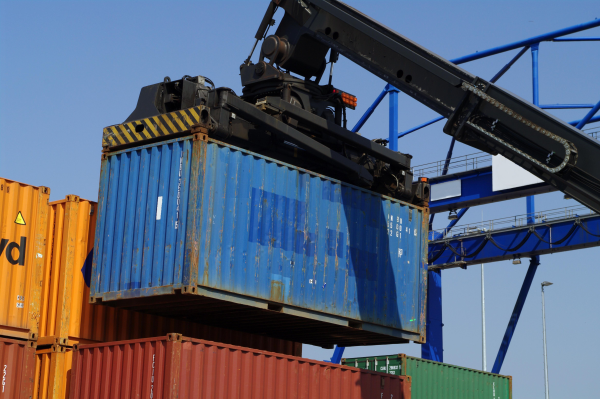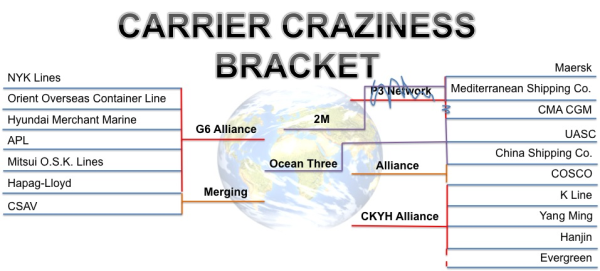What’s wrong with U.S. ports?
 Now that the contract negotiations between the International Longshore & Warehouse Union (ILWU) and the Pacific Maritime Association (PMA) are over (pending ILWU members ratifying the new contract), cargo delays on the West Coast should end too, right?
Now that the contract negotiations between the International Longshore & Warehouse Union (ILWU) and the Pacific Maritime Association (PMA) are over (pending ILWU members ratifying the new contract), cargo delays on the West Coast should end too, right?
Wrong.
And delays are happening at ports on the East Coast as well as the West Coast.
What is the problem that is so costly for U.S. ports and international shippers?
The answer to that question can be summed up with the top international shipping buzzwords of the last few years.
Knowing these buzzwords will not only give you an overview of what is happening in international shipping right now, but also make you look cool and sound well-informed at shipping or economy parties. Those are the best parties, right?
We start with the biggest international shipping buzzword of this last year:
Buzzword #1: Congestion
If you’re a regular reader of Universal Cargo Management’s blog, you’ve read this word many times over the last year. In fact, if you keep up on international shipping news in general, especially as it pertains to U.S. ports, shippers, and the country’s economy, you’ve been hearing this word a great deal.
Congestion, congestion, congestion. Now you’ve seen it three more times.
Congestion is what’s happening at U.S. ports and it has been especially bad at West Coast ports during the labor strife of the ILWU contract negotiations.
Many believe the labor slowdowns and mini lockouts during the ILWU contract negotiations were the cause of the congestion at West Coast ports. They’re wrong. Bitter negotiations between the ILWU and PMA did not cause the congestion on the West Coast, they merely made it much, much worse.
What caused West Coast port congestion? The same thing causing congestion at many ports on the East Coast. While there are many factors causing congestion, the biggest factor is concentrated numbers of shipping containers arriving at the ports at once.
That brings us to last year’s top international shipping buzzword.
Buzzword #2: Alliances
We’re not talking about just any alliances here. We’re talking about carrier alliances.
Big shipping companies known as carriers run shipping lines that carry ocean freight shipping containers across the seas from one country to another.
Unfortunately for these shipping companies, they’ve struggled in recent years to make a profit. One of the ways carriers have sought to change their money-losing ways is by forming operational alliances with other shipping companies for transporting cargo across shipping lanes.
This presents a great excuse for me to bust out my Carrier Craziness Bracket to show how many carriers have joined together in alliances.

On the outside of the Carrier Craziness Bracket, carriers involved in alliances are listed. They are then connected to the carriers with which they’ve formed alliances.
The big thing to take away from the Carrier Craziness Bracket is that a lot of carriers have formed alliances.
How does this cause congestion?
The way these alliances work together is by filling jointly operated ships with cargo. This way, ships that are fully loaded with shipping containers, or as fully loaded as the carriers can manage, arrive at ports for all those shipping containers to be unloaded at once.
But these as fully loaded as possible ships are not just any ships. That’s right, this brings us to the top international shipping buzzword from a couple years ago (but still a very pertinent internationsl shipping buzzword today)…
Buzzword #3: Megaships
The container ships arriving at ports are much larger than the container ships of years past.
An international shipping trend started happening in the years leading up to now where carriers ordered huge ships known as megaships to be built and delivered. In the last couple years, megaships have been hitting the waters and changing the international shipping scene.
The Wall Street Journal likes to point out that many of these megaships would be taller than the Empire State Building if stood on end.
Carrier alliances work together to fill up megaships that then arrive at U.S. ports which are not actually prepared to effectively and efficiently handle that kind of container volume at once.
A recent Wall Street Journal article shares the kinds of shipping container numbers a single ship can deliver to West Coast and East Coast ports in the U.S.:
West Coast ports already receive megaships bearing as many as 14,000 containers traveling from Asia across the Pacific Ocean, while East Coast ones are receiving 10,000-container vessels from Asia through the Suez Canal. That volume will only grow when expansion of the Panama Canal is completed next year. The widened, deeper canal will allow ships carrying as many as 13,000 containers to travel en route to the East Coast, compared with ships hauling 5,000 containers today.
Congestion will continue as carrier alliances continue to fill megaships and deliver larger quantities of shipping containers to U.S. ports than the ports are able to handle.
U.S. ports are working on improving their infrastructure to handle these megaships, but face budgetary problems, unions resisting mechanization, and space shortages just to list a few of the challenges.
Of course, how the ports can change to keep up with modern international shipping and what they’re actually doing to fight congestion caused by carrier alliances delivering megaships full of shipping containers is a blog for another day.
In the meantime, shippers can expect delays to continue at U.S. ports.
